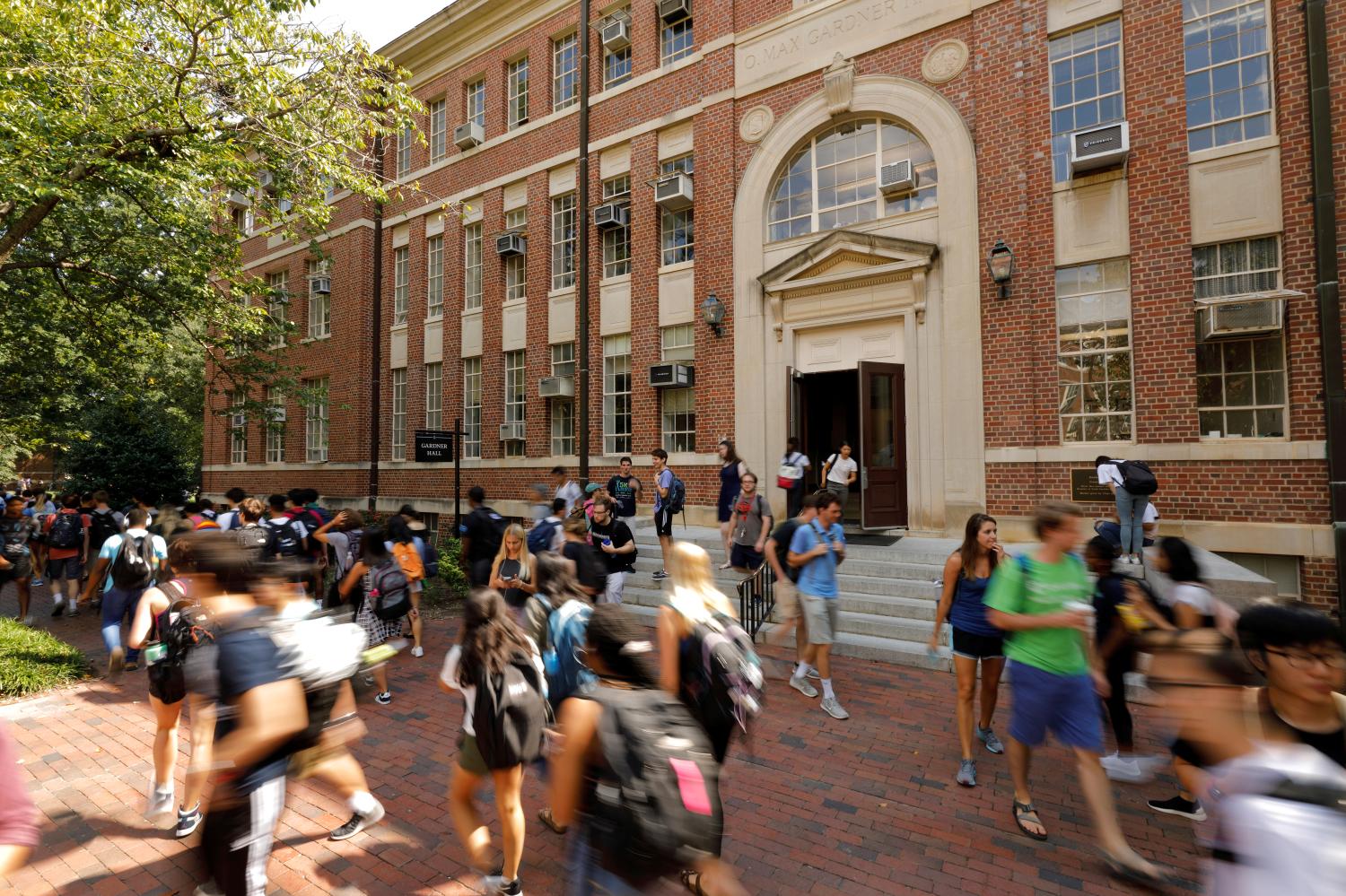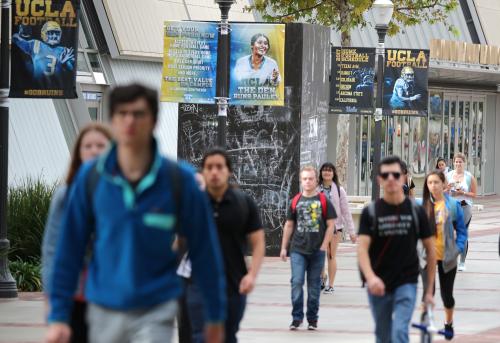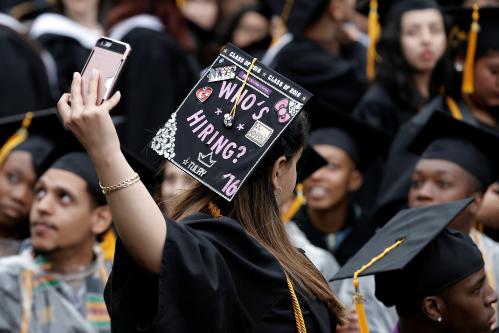When it comes to student loans, undergraduate students receive most of the public’s attention and are the primary focus of federal accountability policies intended to reduce defaults and prevent poor borrowing outcomes. Indeed, the Department of Education doesn’t even publish default rates for loans to graduate students or parents.
But as we show in this post, recent trends in federal graduate student lending raise many of the same concerns surfacing among undergraduate students. Historically, graduate borrowers were considered safer and less risky than undergraduate borrowers, so the federal government applied less oversight and accountability, and was more generous in terms of when and how much graduate students can borrow. Indeed, starting in 2006 under the PLUS program, graduate borrowers can take federal loans up to the cost of attendance (tuition plus other standard expenses like room and board) for any program offered by an eligible institution. At the same time, repayment terms have eased, thanks to income-driven repayment programs that allow students to reduce monthly payments and repay loans over a longer period.
The expansion in credit availability and other factors have led to a worrisome increase in loan burdens, the entry of new institutions and graduate offerings, and worsening repayment outcomes, trends that parallel the deteriorating outcomes among undergraduate borrowers. For instance:
- Graduate students’ average annual borrowing amount has almost doubled over the past 30 years.
- The composition of borrowers has changed, with more graduate students attending for- profit schools
- Default rates1 are relatively higher among for-profit graduate borrowers, and have been increasing across the board, but especially among borrowers at for-profit schools. The overall default rate among graduate borrowers is rising both because of rising rates within sectors but also because of the shift in enrollment to the for-profit sector.
- Students’ success varies widely across institutions. The variation in graduate borrower outcomes across institutions is just as large as the variation in undergraduate outcomes, suggesting that not all graduate schools or programs lead to successful careers and thus loan repayment.
Below, we discuss trends in graduate borrowing, their implications, and their potential causes in more detail.
What we know about graduate borrowers and repayment
Historically, graduate borrowers seemed like rock-solid credits. Almost all graduate borrowers attended high-quality programs at 4-year public and private non-profit institutions, where they generally needed to have completed an undergraduate degree to attend. While loan limits were more generous than for undergraduates, they were still limited to a modest level. Thus, when students selected higher-cost institutions and borrow more than the federal government was willing to lend, they had to turn to the private market, which provided a private-market assessment of whether the borrowers’ institution and intended program of study were likely to pay-off. As a result, graduate borrowers have had very low default rates: between 1999 and 2008, 3-year default rates of graduate borrowers was around 2 percent (Treasury tabulations of NSLDS, Table 18).
But this is changing. Fueled by expansions in the generosity of federal loan policies:
- The amounts graduate students borrow are rising rapidly, reaching levels far above historical norms. Annual borrowing amounts have roughly doubled over the last 30 years. In 1990 the average graduate borrower borrowed around $11,900 per year (adjusted for inflation); in 2014 it was $23,900. (For comparison, the average undergraduate taking out new loans borrowed about $7,300 in 2014.) This means that the average borrower with graduate debt entering repayment in 1990 had $19,400 in debt, and in 2014 about $65,000—this excludes any undergraduate debt. The increase in graduate borrowing has led to a surge in the number of federal borrowers with very large loan balances: 20 percent of graduate borrowers entering repayment in 2014 owed more than $100,000, versus 8 percent in 2000 (Looney and Yannelis, 2018). Now, a relatively small share of borrowers owes the majority of student loan dollars in the United States (Looney and Yannelis 2018).
- Borrowers with large balances make-up an increasingly large share of the federal portfolio. While borrowers with large balances are not typical, they account for a growing share of all student loans. Borrowers with balances above $100,000, who make-up only 5.5 percent of all borrowers, owe a third of all student loan debt. These borrowers are almost exclusively students with some graduate debt (but also some parent borrowers; undergraduates cannot accumulate such balances directly given loan limits). While those borrowers rarely default, when they do there is a lot of money involved. Large balance borrowers owing more than $50,000 account for almost 30 percent of all dollars in default, but are only about 17 percent of student borrowers in 2014 (Looney and Yannelis, 2018).
- Repayment outcomes of graduate borrowers appear to be getting worse. We do not have a standardized and regularly-occurring indicators of graduate borrower outcomes, as there is no official source that tracks them. On the surface, however, graduate borrower outcomes appear to be getting worse. Graduate students’ default rates are low, but they are creeping-up: the 5-year default rate was about 3 percent in 2000, but about 5 percent in 2009. Repayment rates also seem to be falling as more borrowers sign-up for income-driven repayment (IDR) plans. Graduate borrowers leaving school in 2000 had repaid about 16 percent of their loan balance after 5 years, compared to about 11.5 percent in the 2009 cohort. Further, a growing share of large-balance borrowers are in negative amortization. For the first time starting in the early 2010s, large-balance borrowers owe more than their initial repayment amount in the first years of repayment (Looney and Yannelis 2018).
- Many more graduate and large balance borrowers are borrowing to attend for-profit schools, which tend to have worse outcomes. In 1990 about 1 percent of active graduate borrowers attended for-profits. By 2014, the for-profit share of graduate students had increased to 17 percent. The rise in for-profit attendance is larger for borrowers with large balances: among graduate borrowers who owe more than $50,000, increase in for-profit share was from 3 percent to 21 percent.
- Borrowers with large balances make-up an increasingly large share of the federal portfolio. While borrowers with large balances are not typical, they account for a growing share of all student loans. Borrowers with balances above $100,000, who make-up only 5.5 percent of all borrowers, owe a third of all student loan debt. These borrowers are almost exclusively students with some graduate debt (but also some parent borrowers; undergraduates cannot accumulate such balances directly given loan limits). While those borrowers rarely default, when they do there is a lot of money involved. Large balance borrowers owing more than $50,000 account for almost 30 percent of all dollars in default, but are only about 17 percent of student borrowers in 2014 (Looney and Yannelis, 2018).
- Repayment outcomes of graduate borrowers appear to be getting worse. We do not have a standardized and regularly-occurring indicators of graduate borrower outcomes, as there is no official source that tracks them. On the surface, however, graduate borrower outcomes appear to be getting worse. Graduate students’ default rates are low, but they are creeping-up: the 5-year default rate was about 3 percent in 2000, but about 5 percent in 2009. Repayment rates also seem to be falling as more borrowers sign-up for income-driven repayment (IDR) plans. Graduate borrowers leaving school in 2000 had repaid about 16 percent of their loan balance after 5 years, compared to about 11.5 percent in the 2009 cohort. Further, a growing share of large-balance borrowers are in negative amortization. For the first time starting in the early 2010s, large-balance borrowers owe more than their initial repayment amount in the first years of repayment (Looney and Yannelis 2018).
- Many more graduate and large balance borrowers are borrowing to attend for-profit schools, which tend to have worse outcomes. In 1990 about 1 percent of active graduate borrowers attended for-profits. By 2014, the for-profit share of graduate students had increased to 17 percent. The rise in for-profit attendance is larger for borrowers with large balances: among graduate borrowers who owe more than $50,000, increase in for-profit share was from 3 percent to 21 percent.
It is not clear why graduate students at for-profit institutions should fare worse. But on average, they do. Hence, we should be concerned about increased attendance at for-profits simply because student outcomes at these institutions are poor, and have declined further over time. For the 2009 cohort of graduate borrowers, the 5-year default rate among those who had borrowed to attend a for-profit graduate school was 8 percent and, after 5 years, the aggregate loan balance had actually increased by 0.5 percent. On balance, for-profit borrowers had made no progress or, indeed, had fallen slightly behind in repaying their loans. In contrast, the 5-year default rate at public institutions was 5 percent, and these borrowers had repaid 15 percent of their aggregate loan balances. At private non-profit institutions, the 5-year default rate was 4 percent, and balance repaid 12 percent.
- Borrowers with large balances make-up an increasingly large share of the federal portfolio. While borrowers with large balances are not typical, they account for a growing share of all student loans. Borrowers with balances above $100,000, who make-up only 5.5 percent of all borrowers, owe a third of all student loan debt. These borrowers are almost exclusively students with some graduate debt (but also some parent borrowers; undergraduates cannot accumulate such balances directly given loan limits). While those borrowers rarely default, when they do there is a lot of money involved. Large balance borrowers owing more than $50,000 account for almost 30 percent of all dollars in default, but are only about 17 percent of student borrowers in 2014 (Looney and Yannelis, 2018).
- Repayment outcomes of graduate borrowers appear to be getting worse. We do not have a standardized and regularly-occurring indicators of graduate borrower outcomes, as there is no official source that tracks them. On the surface, however, graduate borrower outcomes appear to be getting worse. Graduate students’ default rates are low, but they are creeping-up: the 5-year default rate was about 3 percent in 2000, but about 5 percent in 2009. Repayment rates also seem to be falling as more borrowers sign-up for income-driven repayment (IDR) plans. Graduate borrowers leaving school in 2000 had repaid about 16 percent of their loan balance after 5 years, compared to about 11.5 percent in the 2009 cohort. Further, a growing share of large-balance borrowers are in negative amortization. For the first time starting in the early 2010s, large-balance borrowers owe more than their initial repayment amount in the first years of repayment (Looney and Yannelis 2018).
- Many more graduate and large balance borrowers are borrowing to attend for-profit schools, which tend to have worse outcomes. In 1990 about 1 percent of active graduate borrowers attended for-profits. By 2014, the for-profit share of graduate students had increased to 17 percent. The rise in for-profit attendance is larger for borrowers with large balances: among graduate borrowers who owe more than $50,000, increase in for-profit share was from 3 percent to 21 percent.
It is not clear why graduate students at for-profit institutions should fare worse. But on average, they do. Hence, we should be concerned about increased attendance at for-profits simply because student outcomes at these institutions are poor, and have declined further over time. For the 2009 cohort of graduate borrowers, the 5-year default rate among those who had borrowed to attend a for-profit graduate school was 8 percent and, after 5 years, the aggregate loan balance had actually increased by 0.5 percent. On balance, for-profit borrowers had made no progress or, indeed, had fallen slightly behind in repaying their loans. In contrast, the 5-year default rate at public institutions was 5 percent, and these borrowers had repaid 15 percent of their aggregate loan balances. At private non-profit institutions, the 5-year default rate was 4 percent, and balance repaid 12 percent.
- Borrowers with large balances make-up an increasingly large share of the federal portfolio. While borrowers with large balances are not typical, they account for a growing share of all student loans. Borrowers with balances above $100,000, who make-up only 5.5 percent of all borrowers, owe a third of all student loan debt. These borrowers are almost exclusively students with some graduate debt (but also some parent borrowers; undergraduates cannot accumulate such balances directly given loan limits). While those borrowers rarely default, when they do there is a lot of money involved. Large balance borrowers owing more than $50,000 account for almost 30 percent of all dollars in default, but are only about 17 percent of student borrowers in 2014 (Looney and Yannelis, 2018).
- Repayment outcomes of graduate borrowers appear to be getting worse. We do not have a standardized and regularly-occurring indicators of graduate borrower outcomes, as there is no official source that tracks them. On the surface, however, graduate borrower outcomes appear to be getting worse. Graduate students’ default rates are low, but they are creeping-up: the 5-year default rate was about 3 percent in 2000, but about 5 percent in 2009. Repayment rates also seem to be falling as more borrowers sign-up for income-driven repayment (IDR) plans. Graduate borrowers leaving school in 2000 had repaid about 16 percent of their loan balance after 5 years, compared to about 11.5 percent in the 2009 cohort. Further, a growing share of large-balance borrowers are in negative amortization. For the first time starting in the early 2010s, large-balance borrowers owe more than their initial repayment amount in the first years of repayment (Looney and Yannelis 2018).
- Many more graduate and large balance borrowers are borrowing to attend for-profit schools, which tend to have worse outcomes. In 1990 about 1 percent of active graduate borrowers attended for-profits. By 2014, the for-profit share of graduate students had increased to 17 percent. The rise in for-profit attendance is larger for borrowers with large balances: among graduate borrowers who owe more than $50,000, increase in for-profit share was from 3 percent to 21 percent.
It is not clear why graduate students at for-profit institutions should fare worse. But on average, they do. Hence, we should be concerned about increased attendance at for-profits simply because student outcomes at these institutions are poor, and have declined further over time. For the 2009 cohort of graduate borrowers, the 5-year default rate among those who had borrowed to attend a for-profit graduate school was 8 percent and, after 5 years, the aggregate loan balance had actually increased by 0.5 percent. On balance, for-profit borrowers had made no progress or, indeed, had fallen slightly behind in repaying their loans. In contrast, the 5-year default rate at public institutions was 5 percent, and these borrowers had repaid 15 percent of their aggregate loan balances. At private non-profit institutions, the 5-year default rate was 4 percent, and balance repaid 12 percent.
Thus far, the analysis has examined trends in borrowing and outcomes at relatively aggregated levels. At the institution level, however, outcomes vary far more widely—as widely as do outcomes across institutions at the undergraduate level (Chou, Looney, and Watson 2017). Average outcomes mask very large differences between borrowers from different schools, and probably different programs.
Institutions that have strong or weak undergraduate repayment outcomes also have similarly strong or weak graduate repayment outcomes. For instance, at large for-profit institutions with large graduate programs, like Strayer University, American Intercontinental University, Walden University, and Grand Canyon University. The 5-year graduate repayment rates for those entering repayment in 2009 were 3 percent, 10 percent, 13 percent, and 19 percent respectively. Public and private non-profit institutions tend to fare better. For instance, at the University of Minnesota, it was 24 percent, and at Michigan State University, it was 28 percent.
This is important because it means that some institutions are systematically producing graduate borrowers who are unable to make progress repaying their loans. Ultimately these programs are being subsidized by other programs (whose graduates are more successful) or by taxpayers.
- Borrowers with large balances make-up an increasingly large share of the federal portfolio. While borrowers with large balances are not typical, they account for a growing share of all student loans. Borrowers with balances above $100,000, who make-up only 5.5 percent of all borrowers, owe a third of all student loan debt. These borrowers are almost exclusively students with some graduate debt (but also some parent borrowers; undergraduates cannot accumulate such balances directly given loan limits). While those borrowers rarely default, when they do there is a lot of money involved. Large balance borrowers owing more than $50,000 account for almost 30 percent of all dollars in default, but are only about 17 percent of student borrowers in 2014 (Looney and Yannelis, 2018).
- Repayment outcomes of graduate borrowers appear to be getting worse. We do not have a standardized and regularly-occurring indicators of graduate borrower outcomes, as there is no official source that tracks them. On the surface, however, graduate borrower outcomes appear to be getting worse. Graduate students’ default rates are low, but they are creeping-up: the 5-year default rate was about 3 percent in 2000, but about 5 percent in 2009. Repayment rates also seem to be falling as more borrowers sign-up for income-driven repayment (IDR) plans. Graduate borrowers leaving school in 2000 had repaid about 16 percent of their loan balance after 5 years, compared to about 11.5 percent in the 2009 cohort. Further, a growing share of large-balance borrowers are in negative amortization. For the first time starting in the early 2010s, large-balance borrowers owe more than their initial repayment amount in the first years of repayment (Looney and Yannelis 2018).
- Many more graduate and large balance borrowers are borrowing to attend for-profit schools, which tend to have worse outcomes. In 1990 about 1 percent of active graduate borrowers attended for-profits. By 2014, the for-profit share of graduate students had increased to 17 percent. The rise in for-profit attendance is larger for borrowers with large balances: among graduate borrowers who owe more than $50,000, increase in for-profit share was from 3 percent to 21 percent.
It is not clear why graduate students at for-profit institutions should fare worse. But on average, they do. Hence, we should be concerned about increased attendance at for-profits simply because student outcomes at these institutions are poor, and have declined further over time. For the 2009 cohort of graduate borrowers, the 5-year default rate among those who had borrowed to attend a for-profit graduate school was 8 percent and, after 5 years, the aggregate loan balance had actually increased by 0.5 percent. On balance, for-profit borrowers had made no progress or, indeed, had fallen slightly behind in repaying their loans. In contrast, the 5-year default rate at public institutions was 5 percent, and these borrowers had repaid 15 percent of their aggregate loan balances. At private non-profit institutions, the 5-year default rate was 4 percent, and balance repaid 12 percent.
Thus far, the analysis has examined trends in borrowing and outcomes at relatively aggregated levels. At the institution level, however, outcomes vary far more widely—as widely as do outcomes across institutions at the undergraduate level (Chou, Looney, and Watson 2017). Average outcomes mask very large differences between borrowers from different schools, and probably different programs.
Institutions that have strong or weak undergraduate repayment outcomes also have similarly strong or weak graduate repayment outcomes. For instance, at large for-profit institutions with large graduate programs, like Strayer University, American Intercontinental University, Walden University, and Grand Canyon University. The 5-year graduate repayment rates for those entering repayment in 2009 were 3 percent, 10 percent, 13 percent, and 19 percent respectively. Public and private non-profit institutions tend to fare better. For instance, at the University of Minnesota, it was 24 percent, and at Michigan State University, it was 28 percent.
This is important because it means that some institutions are systematically producing graduate borrowers who are unable to make progress repaying their loans. Ultimately these programs are being subsidized by other programs (whose graduates are more successful) or by taxpayers.
What do these trends imply?
In all, these trends have important implications. From the student’s perspective, many graduate students are saddled with large and rising debt burdens—burdens that have increased faster than typical earnings. While they can avoid default and reduce their monthly payments through income-driven repayment plans, those plans can impose significant costs on borrowers because payments are mostly deferred (with interest).
Expanded eligibility for credit and higher loan limits also distort educational offerings. It encourages schools to offer programs that they would not otherwise have and charge higher tuition. Finally, there in an increased fiscal cost. For instance, on a fair-value basis, the Congressional Budget Office estimates that the federal government will spend about 16 cents per each new dollar loaned in 2019, a subsidy stems, in part, from offering loans on more generous terms and to finance educational investments that the private sector would not offer (CBO 2018).
Why are these trends happening?
These trends are largely a consequence of several federal policy changes that expanded credit. Policies increased graduate loan limits, and eliminated the PLUS caps. The government also expanded the types of institutions and programs that are eligible to take Title IV funds: it eliminated the 50 percent distance learning limit2, and changed the 85/15 rule to 90/103. Additionally, the government enacted repayment plans and loan subsidy programs that eased the burden on borrowers, especially those who borrowed large amounts. (One reason total student debt is rising faster in recent years is that students are repaying loans more slowly.) Policymakers also enacted or expanded generous Public Sector Loan Forgiveness (PSLF) and Income-Driven Repayment plans; under these plans borrowers’ payments may be capped at 10 percent of disposable income and any remaining balance can be forgiven (in as few as 10 years under PSLF). Students anticipating loan forgiveness have little incentive to be concerned with the cost or value of the education they are pursuing—and institutions may have little difficulty raising their prices.
These changes occurred in the absence of a federal system of accountability relevant for graduate borrowers, like that which applies to undergraduates (Cohort Default Rate rules). In all, these changes have directly increased the amounts that students can borrow.
But these changes have also had indirect effects. The expansion of graduate PLUS loans replaced private sector loans (where lenders scrutinized borrowers’ ability to repay), and thereby expanded credit to institutions and programs that would not have been financed by the private sector.
The changes have probably made the federal aid program more regressive and reduced the returns on investment. The largest beneficiaries of these repayment plans are likely to be graduate borrowers. More than 40 percent of borrowers who owe more than $100,000 are enrolled in IDR plans, and 50 percent of borrowers owe over $200,000. Only 4 percent of borrowers enrolled have balances under $5,000. About 35 percent of student loan debt is owed by borrowers in the top 20 percent of the income distribution, and borrowers with the largest balances tend to earn more (and come from higher-income family backgrounds) than borrowers with smaller balances (Looney and Yannelis 2016) . Finally, the credit expansions were used to finance institutions that were generally of lower quality, and for programs of study that the private sector had declined to finance in the past.
Conclusion
One lesson from analyzing undergraduate student loan outcomes is that the increase in default rates is largely about changes in which schools and programs students borrow to attend, not other factors like the unemployment rate or background characteristics of the students themselves. Federal policy expanded, contracted, and then re-expanded credit to 1) lower-quality institutions and programs, and 2) students who, given the institutions they attend and their earnings potential, are at higher risk of default.
In contrast to for-profits, default rates at most public- and private non-profit institutions have changed little over time, and at modestly selective institutions, it is lower now than it was over most of the 1980s and 1990s. This is not a surprise—undegraduate borrowers that attend good programs and earn degrees borrow modest amounts, achieve high earnings after they graduate, and are relatively protected from economic cycles. For instance, unemployment rates for college graduates peaked at 5 percent during the great recession, half the rate for high-school graduates (BLS).
In essence, there has been a dramatic increase in the number of borrowers leaving college with high debt and low earnings over the past decade. This has resulted in unsustainable debt burdens that impose substantial costs on students and federal taxpayers. Although good data on graduate borrowers is not available, the same is likely true among graduate students. The fact that we are seeing similar trends in the composition of graduate borrowers is troubling, not only because of the sheer dollar amounts involved, but also because there is relatively less publicity and thus pressure to address these group of borrowers.
Financial aid policies shouldn’t force low-income students to choose between not going to school or taking on debt that they cannot repay. However, we must recognize that some schools do a better job than others in helping low-income students achieve economic success. A better system would limit the credit available to graduate and parent borrowers, and ask higher-income borrowers to repay more of their loan balance. Federal policy should also keep low quality schools in check by strengthening institutional accountability systems. For example, loan eligibility or financial incentives could be tied to their students’ repayment rates, so that schools have a greater stake in their students’ ability to repay loans. Simple accountability measures could reduce adverse outcomes and reduce risks on taxpayers, while still providing fair access to higher education.
Support for this publication was generously provided by the Laura and John Arnold Foundation.
Brookings is committed to quality, independence, and impact in all of its work. Activities supported by its donors reflect this commitment and the analysis and recommendations are solely determined by the scholar.
-
Footnotes
- The default rate is the fraction of borrowers who leave school and are required to begin payment of their loans, but who default within a specified number of years.
- This rule says that no more than 50 percent of a school’s programs may be offered online, and that no more than 50 percent of a school’s regular students may be enrolled in online programs.
- This rule caps the percentage of revenue that a school can receive from federal financial aid sources to 85(90); the other 15(10) must come from alternative sources.







